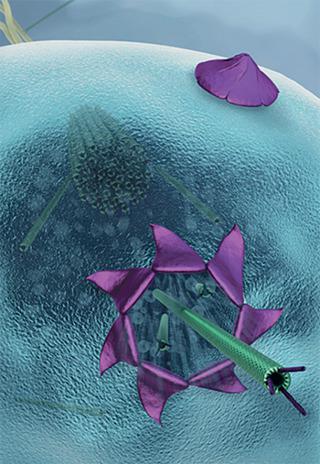当前位置:
X-MOL 学术
›
Cell. Microbiol.
›
论文详情
Our official English website, www.x-mol.net, welcomes your
feedback! (Note: you will need to create a separate account there.)
Egress of archaeal viruses
Cellular Microbiology ( IF 2.6 ) Pub Date : 2021-09-13 , DOI: 10.1111/cmi.13394 Diana P Baquero 1 , Junfeng Liu 1 , David Prangishvili 1, 2
Cellular Microbiology ( IF 2.6 ) Pub Date : 2021-09-13 , DOI: 10.1111/cmi.13394 Diana P Baquero 1 , Junfeng Liu 1 , David Prangishvili 1, 2
Affiliation

|
Viruses of Archaea, arguably the most mysterious part of the virosphere due to their unique morphotypes and genome contents, exploit diverse mechanisms for releasing virus progeny from the host cell. These include virus release as a result of the enzymatic degradation of the cell wall or budding through it, common for viruses of Bacteria and Eukarya, as well as a unique mechanism of virus egress through small polygonal perforations on the cell surface. The process of the formation of these perforations includes the development of pyramidal structures on the membrane of the infected cell, which gradually grow by the expansion of their faces and eventually open like flower petals. This mechanism of virion release is operating exclusively in cells of hyperthermophilic hosts from the phylum Crenarchaeota, which are encased solely by a layer of surface proteins, S-layer. The review focuses on recent developments in understanding structural and biochemical details of all three types of egress mechanisms of archaeal viruses.
中文翻译:

古细菌病毒的出口
由于其独特的形态型和基因组内容,古生菌病毒可以说是病毒圈中最神秘的部分,它利用多种机制从宿主细胞中释放病毒后代。这些包括由于细胞壁的酶促降解或通过细胞壁出芽而释放的病毒,常见于细菌和真核生物的病毒,以及病毒通过细胞表面上的小多边形穿孔排出的独特机制。这些穿孔的形成过程包括受感染细胞膜上锥体结构的发展,这些锥体结构通过其面部的扩大逐渐生长并最终像花瓣一样张开。这种病毒粒子释放机制仅在来自 Crenarchaeota 门的超嗜热宿主细胞中起作用,它们仅被一层表面蛋白S层包裹。这篇综述重点介绍了在了解所有三种古菌病毒出口机制的结构和生化细节方面的最新进展。
更新日期:2021-09-13
中文翻译:

古细菌病毒的出口
由于其独特的形态型和基因组内容,古生菌病毒可以说是病毒圈中最神秘的部分,它利用多种机制从宿主细胞中释放病毒后代。这些包括由于细胞壁的酶促降解或通过细胞壁出芽而释放的病毒,常见于细菌和真核生物的病毒,以及病毒通过细胞表面上的小多边形穿孔排出的独特机制。这些穿孔的形成过程包括受感染细胞膜上锥体结构的发展,这些锥体结构通过其面部的扩大逐渐生长并最终像花瓣一样张开。这种病毒粒子释放机制仅在来自 Crenarchaeota 门的超嗜热宿主细胞中起作用,它们仅被一层表面蛋白S层包裹。这篇综述重点介绍了在了解所有三种古菌病毒出口机制的结构和生化细节方面的最新进展。











































 京公网安备 11010802027423号
京公网安备 11010802027423号